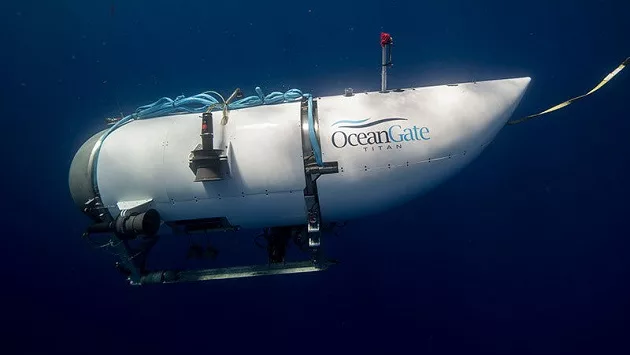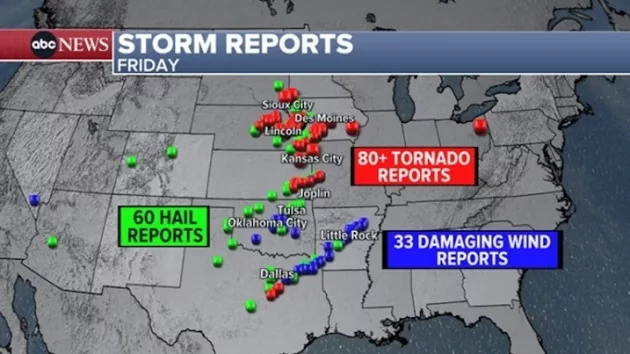(NEW YORK) — As the search-and-rescue efforts became a recovery mission Thursday, U.S. Coast Guard officials conceded they are facing a daunting investigation to determine what caused the Titan submersible to implode underwater near the wreckage of the Titanic, killing all five explorers aboard.
After searching for five days for the OceanGate Expedition vessel, Coast Guard Rear Adm. John Mauger announced that a “catastrophic event” doomed the five men aboard the minisub.
Believed to have been killed in the undersea disaster were OceanGate CEO Stockton Rush, paying passengers billionaire Shahzada Dawood and his 19-year-old son Suleman Dawood, aviation tycoon Hamish Harding and Paul-Henri Nargeolet, a renowned expert on the Titanic.
“We immediately notified the families,” Mauger said at a news conference. “On behalf of the United States Coast Guard and the entire united command, I offer my deepest condolences to the families. I can only imagine what this has been like for them and I hope that this discovery provides some solace during this difficult time.”
Officials said the 21-foot-long Titan was found in pieces by a remotely operated vehicle on a smooth section of ocean floor more than 2 miles beneath the surface and 1,600 feet from the bow of the Titanic, which crashed into an iceberg on April 15, 1912, in the North Atlantic Ocean, four days into her maiden voyage from Southampton, England, to New York City, killing an estimated 1,490 to 1,635 people aboard.
“This was an incredibly complex case and we’re still working to develop details for the timeline involved with this casualty and the response,” Mauger said.
Five major pieces of the Titan, including its nose cone and pressure hull, were discovered by the ROV in a large debris field and a smaller debris field nearby, suggesting a major implosion had occurred, officials said.
Mauger said it remains unclear whether crews will be able to recover the bodies of the five people killed and how much of the vessel can be salvaged.
“This is an incredibly unforgiving environment down there on the sea floor and the debris is consistent with a catastrophic implosion of the vessel,” Mauger said.
He said two ROVs, one from France and the other from Canada, will remain at the site off the coast of Newfoundland, Canada, to continue mapping the debris fields.
“We’ll continue to work and continue to search the area down there, but I don’t have an answer for a prospect at this time,” Mauger said, referring to the recovery of the bodies.
Mauger said an investigation is underway to determine when the implosion happened on the Titan’s voyage to the Titanic.
The tourist expedition to the Titanic was launched at 8 a.m. on Sunday. The Titan’s companion surface ship lost contact with the explorers an hour and 45 minutes into the trip, Coast Guard officials said.
“We know that as we’ve been prosecuting this search over the course of the last 72 hours and beyond that we’ve had sonar buoys in the water nearly continuously and have not detected any catastrophic events where the sonar buoys have been in the water,” said Mauger, suggesting the implosion occurred at the outset of the voyage.
He said the Coast Guard and the British and French governments will keep investigating to answer “how, why and when this happened.”
“Those are questions that we will collect as much information as we can now while the governments are meeting and discussing what an investigation of this nature of casualty might look like,” Mauger said. “This is something that happened in a remote part of the ocean with people from different countries around the world and so it is a complex case to work through. But I’m confident that those questions will begin to get answers.”
He added, “Right now, our thoughts are with the families and making sure that they have an understanding as best as we can provide of what happened and begin to find some closure.”
A former employee of OceanGate alleged in a 2018 counterclaim lawsuit that he was fired for raising concerns about quality control and testing of potential flaws in the same experimental submersible that imploded.
David Lochridge, an engineer and submarine pilot, claimed in his counterclaim against OceanGate that he was hired in 2015 by the Everett, Washington, company to ensure the safety of all crew and clients during the submersible and surface operations of the vessel called Titan. Lochridge, according to the suit, raised concerns about the design and strength of the submersible’s hull, particularly that it was made of carbon fiber instead of a metallic composition.
But when he expressed concerns about the design and testing of the minisub’s hull, he said he was terminated by the company.
OceanGate had initially sued Lochridge alleging, among other things, breach of contract, fraud and misappropriation of trade secrets — all claims he denied. Both OceanGate’s lawsuit and Lochridge’s countersuit were settled out of court.
It remains unclear if any of the concerns that Lochridge raised were a factor in the Titan disaster.
Copyright © 2023, ABC Audio. All rights reserved.





